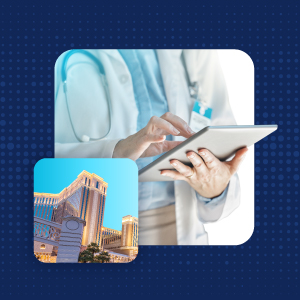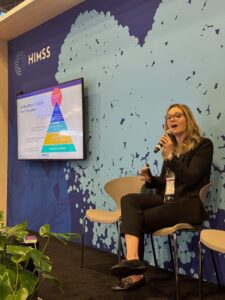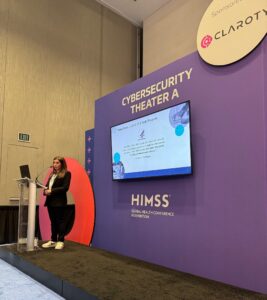At the Healthcare Information and Management Systems Society (HIMSS) Global Health Conference and Exhibition 2025, health IT professionals, healthcare personnel and Government leaders joined to connect on the latest trends in the healthcare industry. As a provider and distributor of health IT solutions, Carahsoft and its partners are equipped to communicate recent trends and connect care providers, agencies and companies with the technology they need to embrace the future of healthcare.
Here are the top 5 insights for the technology industry and Government from this year’s conference.
1. Utilizing Artificial Intelligence in Healthcare
Healthcare must ensure all provided tools are safe, effective and ethical to ensure the best outcomes for patients. As the widespread adoption of artificial intelligence in the healthcare industry is relatively new, providers and public health officials should employ risk management practices, strong governance and transparency with their usage of the tool.
Providers should employ best practices for AI usage:
- Understand AI’s risk profile
- Ensure that data is representative of patients
- Address potential biases
With continuous monitoring, providers can mitigate any potential model drifts and gain better oversight of the dynamic nature of AI systems. By highlighting the areas of risk, the healthcare system can make informed decisions on which tools, solutions and personnel to deploy to mitigate risk.

There are many opportunities for AI in Healthcare. In the session “HL’s Ride on the AI Train,” the Chief Executive Officer of HL7 International, Charles Jaffe, discussed how AI can enable healthcare providers to promote interoperability. AI can also help providers address industry concerns, such as data provenance and data lineage. In the session “Shaping the Future of healthcare: A Collaborative Care Journey Where Technology and Humanity Coexist,” speakers Seung Woo Park and Meong Hi Son, respectively the President and Chief Medical Information Officer and Associate Professor at Samsung Medical Center (SMC), mentioned that SMC reduced the nurse turnover rate from 9.3% to 5.9% by assisting their workflow with AI and automation. In the session “Disruptive Technologies: Examining the Challenges and Opportunities of Cyber, AI and Beyond,” the Former Commander and U.S. Cyber Command and Former Director at the National Security Agency, Paul Nakasone, noted that AI-driven behavior changes could transform healthcare and prevent chronic diseases. Using AI to get suggestions on sleep, meditation, diet and stress management can all help in between doctor visits to chip away at chronic diseases. Through the collaboration of providers and technology, service in healthcare can be reshaped for the better, providing a gateway into personal medicine.
2. Improving Healthcare Quality through Interoperability
Another point of discussion at HIMSS was the role of digital technology and standards in improving healthcare quality. The National Committee for Quality Assurance (NCQA) has several initiatives, such as the Healthcare Effectiveness Data and Information Set (HEDIS) Fast Healthcare Interoperability Resources (FHIR) data model and the Bulk FHIR Quality Coalition, aimed at enhancing digital quality measurement by enabling end-to-end FHIR data exchanges. Quality measurement has evolved, and standardized clinical data helps accelerate that evolution. With modern computing platforms and technologies, such as Bulk FHIR, healthcare institutions can utilize real-time, continuous data processing, improving data encryption, data security and quality measurement. With comprehensive and timely data sharing among healthcare stakeholders, patients can get results from labs and pharmacies quicker, and can share their data across different healthcare offices, improving the affordability and quality of services.
3. Addressing Veteran Needs in Collaboration with CMS
On average, patients have their medical data located at 5.6 different locations, making interoperability, the ability of information to be exchanged between different health systems or technology systems, instrumental in helping patients and providers alike to improve the healthcare experience.
In the session “A Discussion: Transforming Care Through Interoperability,” members of the Department of Veteran Affairs (VA) and University of Oklahoma discussed the benefits of interoperability for veterans. Data sharing between the VA and the Center for Medicare and Medicaid Services (CMS) can address healthcare challenges, such as dementia, suicidal ideation, traumatic brain injury (TBI) and oncology by enabling the two agencies to collaborate to achieve actionable approaches for real-world cases. For example, improving care coordination, optimizing resource utilization and driving better outcomes for veterans and other patients.
Data sharing and collaboration is key to achieving efficient and effective healthcare delivery in the modernized health data infrastructure. In modernizing the infrastructure of the healthcare industry through interoperability, providers and patients can alleviate the work burden and work towards finding solutions at an expedited and swifter rate. The need for remote patient monitoring tools (RPM) is key to assist physicians and clinicians with increased data collection to support real-time treatment of these chronic illnesses for our veterans.

4. Leveraging Data to Improve Service
Digital health increases the speed of learning, helps patients and providers overcome health inequity and increases the effectiveness of virtual care. In the session “Case Study: Missouri’s Mission to Transform Digital Health,” speakers Joshua Wymer, the Chief Health Information and Data Strategy Officer of the Missouri Department of Health and Senior Services (DHSS), and Natasha Ramontal, the Digital Health Strategist in Community Outcomes for HIMSS, discussed the DHSS’ journey to transform digital health. To address the needs of businesses, HIMSS and the DHSS teamed up, eliminating duplicate data sets, reducing volumes of data entry and improving regulatory oversight. Through their collaboration in improving the handling of data, the Missouri Department of Health and Senior Services became the first state level organization to successfully implement HIMSS’ Digital Health Indicator model.
5. Bolstering Cybersecurity Mitigation with OCR and HIPAA
In the session “Preparing for OCR’s Revived HIPAA Security Audits,” speaker Nadia Faheem Coster, the Executive Vice President of Permit Intelligence Services, discussed the Department of Health and Human Services’ Office of Civil Rights (OCR) 2025 audit program, which applies to fifty entities and business associates. The audit focuses on decreasing hacking and ransomware attacks.

To combat bad actors, Coster recommends:
- Maintaining a risk management plan
- Conducting annual secure risk assessments
- Ensuring all policies and procedures are up to date
Coster also emphasized the need for segmentation and asset inventory under the proposed Health Insurance Portability and Accountability Act (HIPAA) Security 2.0 rule. All related health systems and the IT industry should ensure their software and hardware are compliant under the proposed ruling. System resiliency is the gold standard for health systems looking to comply with the HIPAA Security 2.0 ruling.
Data sharing, cybersecurity awareness, interoperability and artificial intelligence all enable cheaper and quicker work, whether it is sharing information between healthcare providers or on internal day-to-day operations, while ensuring quality care. By enabling the latest solutions in healthcare technology, health systems can create a better work environment for providers and a seamless experience for patients.
To learn more about interoperability, legislation, cybersecurity and AI in healthcare, visit Carahsoft’s Healthcare Technology solutions portfolio to explore solutions showcased at HIMSS. For additional research into the key takeaways thought, industry and Government leaders presented at HIMSS, view Carahsoft’s extensive market research brief for a deeper dive.

 The cloud is here to stay: Underpinning many new technologies is the cloud. As more healthcare organizations use hybrid and multi-cloud environments, compliance becomes increasingly complicated and important. This is particularly true considering regulations and data protection laws are constantly changing. One benefit is there is a lot of overlap between compliance requirements. Looking for these common requirements (i.e. encrypting sensitive data) can help organizations navigate the seemingly complex world of compliance.
The cloud is here to stay: Underpinning many new technologies is the cloud. As more healthcare organizations use hybrid and multi-cloud environments, compliance becomes increasingly complicated and important. This is particularly true considering regulations and data protection laws are constantly changing. One benefit is there is a lot of overlap between compliance requirements. Looking for these common requirements (i.e. encrypting sensitive data) can help organizations navigate the seemingly complex world of compliance.